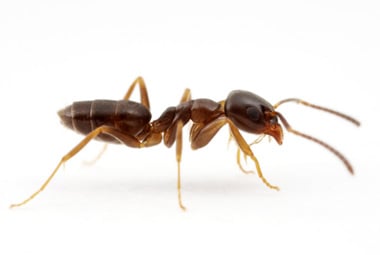
Odorous house ants get their name from the strong pungent odor that they emit after they are crushed. These ants are a native species and can be found living throughout Missouri and throughout the rest of the United States.
| Pest Identification | |
|---|---|
| Recognition | Odorous house ants are dark brown to black in color. They are a small species with adults only growing to be about 1/8th of an inch in length, and when you look at this species from the side, their thorax is uneven in shape. The best way to distinguish these ants from other species is their smell, odorous house ants give off a foul-smelling rotten coconut-like odor when they are crushed. |
| Biology | When an odorous house ant colony is mature, winged reproductive members will swarm from the colony; this usually occurs in the summer months. The males and females will mate; the females will then find a suitable place to create a new nest. The female will lay her eggs; the eggs will hatch and develop from larvae to pupa to adult over a period of 34-83 days. Development time varies based on environmental conditions, mainly temperature. Odorous house ants will also form new colonies through the process of budding. Budding is when a queen takes with her workers from an existing colony; they “bud” off and create a new nest and start a new colony. |
| Habits | The odorous house ant, like other species of ants, will enter homes and other buildings accidentally and/or while foraging for food sources. Once inside of your home they may decide to stay and nest behind walls or underneath floors. They often get inside by traveling underneath doors, through cracks found in the foundation, and/or through the spaces found around windows and doors. They may also enter through the spaces found around utility lines that enter your home. These ants will seek indoor shelter during periods of heavy rains or whenever the ground becomes too saturated with water for them to live comfortably. Odorous house ants prefer to feed on sweets, but if given the opportunity they will happily consume meats and grease. |
| Prevention | The best way to prevent problems with odorous house ants in your home is to put into place a year-round pest control service. Other things that you can do in and around your home to help deter these ants include: Storing woodpiles up off the ground and a distance away from the exterior of your home, Making sure that outdoor trash cans are also stored away from the outside of your home and that they have tight-fitting or locking lids to keep foraging ants and other pests out, Sealing cracks and crevices found in your home’s foundation, and sealing the spaces found around pipes and wires that may be entering your home, Installing door sweeps underneath all exterior doors, Caulking any gaps found around all windows and doors, Washing dirty dishes routinely, quickly cleaning up spills and crumbs, and storing food in the refrigerator or in sealed containers rather than out in the open. |
| Professional | At Rottler, we control odorous house ants that have infested Greater St. Louis homes. When you choose our Signature Pest Protection, a year-round home pest control program, we’ll send a trained pest control technician out to inspect your home for areas where these ants are nesting and/or foraging. After we’ve assessed the situation, our technicians will treat necessary areas to get rid of odorous house ants and other common household pests. Our follow up care includes regularly scheduled visits all year long to ensure that ants and other pests stay away. |

